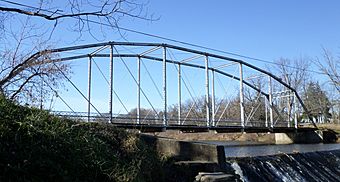Grist Mill Bridge, Dam and Mill Site facts for kids
Quick facts for kids |
|
|
Grist Mill Bridge, Dam and Mill Site
|
|
 |
|
| Location | Upton Rd. from Island Rd. to Maple R., Duplain Township, Michigan |
|---|---|
| Built | 1865, 1901, 1912 |
| Built by | Detroit Bridge & Iron Works |
| NRHP reference No. | 15000295 |
| Added to NRHP | June 1, 2015 |
The Grist Mill Bridge, Dam and Mill Site is a cool historical place in Duplain Township, Michigan. It's located near Elsie, Michigan, along Upton Road. This site includes three important structures that tell a story about the past.
These three parts are:
- The Upton Road Bridge: This is a very old metal bridge. It's the last one of its kind built by the Detroit Bridge & Iron Works in Michigan. It's also one of only three Parker truss bridges left in the state.
- The Elsie Mill Pond Dam: This dam is made of rocks and earth. It has a concrete top and a spillway, which lets water flow over it.
- The Kellogg Bros. & Johnson Mill Site: This is where an old grist mill used to stand. You can still see the foundations and other remains from the mill built in 1865.
All these structures were added to the National Register of Historic Places in 2015. This means they are important to our country's history.
Contents
History of the Grist Mill Site
Duplain Township was first settled by people in the 1830s. Around 1845, a man named Robert E. Craven built a sawmill here. A sawmill uses water power to cut logs into lumber. This mill worked for almost 20 years.
From Sawmill to Grist Mill
In 1865, a group called Kellogg Bros. and Johnson bought the site. They replaced the sawmill with a much bigger grist mill. A grist mill grinds grain, like wheat, into flour. To power this new mill, they built a wooden dam. Around the same time, a bridge was built over the Maple River. This bridge carried Upton Road. The grist mill kept running for many years, even with different owners.
New Bridge and Dam
In 1901, Duplain Township decided to replace the old Upton Road bridge. They hired the Detroit Bridge & Iron Works to build a new steel bridge. This new bridge cost about $2,590 for the steel parts. The total cost, including wood planks and labor, was about $3,228.
Later, in 1912, the wooden dam was replaced. A new dam was built using earth and concrete. This is the Elsie Mill Pond dam we see today. The mill continued to operate until 1950. In 1953, the building was changed into a place for storing animal feed and grain.
The Site Today
Sadly, the mill building burned down in 1969. Only the foundations are left now. In 1976, Duplain Township worked with the Elsie Lions Club. They turned the area into a public park for everyone to enjoy.
What the Site Looks Like
The Grist Mill site is located right on the Maple River. The Upton Road Bridge crosses the river here. The old mill site is on the south bank of the river. Duplain Township owns this land and takes care of it as a park.
Upton Road Bridge Details
The Upton Road bridge is a single-span bridge. It's made of steel and uses a special design called a Parker truss. It is 160 feet long and 16 feet wide. The bridge deck, where cars used to drive, is made of wooden planks. These planks have wooden blocks and a layer of asphalt on top.
Grist Mill Dam Details
The Grist Mill Dam is about 150 feet long. It stands about 12 to 15 feet high. The main part of the dam is built from rocks and earth. On top, there's a concrete cap and a spillway. The spillway lets water flow over the dam. It empties onto a flat concrete area below. Concrete supports are built at each end of the dam.
Kellogg Bros. & Johnson Grist Mill Site Details
At the old grist mill site, you can see parts of the original building. There's a stone wall made of rubble fieldstone. You can also see the foundation walls of the mill itself. The mill's foundation is shaped like an "L." Its longer walls are about 75 to 85 feet long, and the shorter wall is about 20 feet long. Some of these walls are still up to 15 feet high. You can also find signs of two flumes. These were channels that carried water from the mill pond to power the mill.


